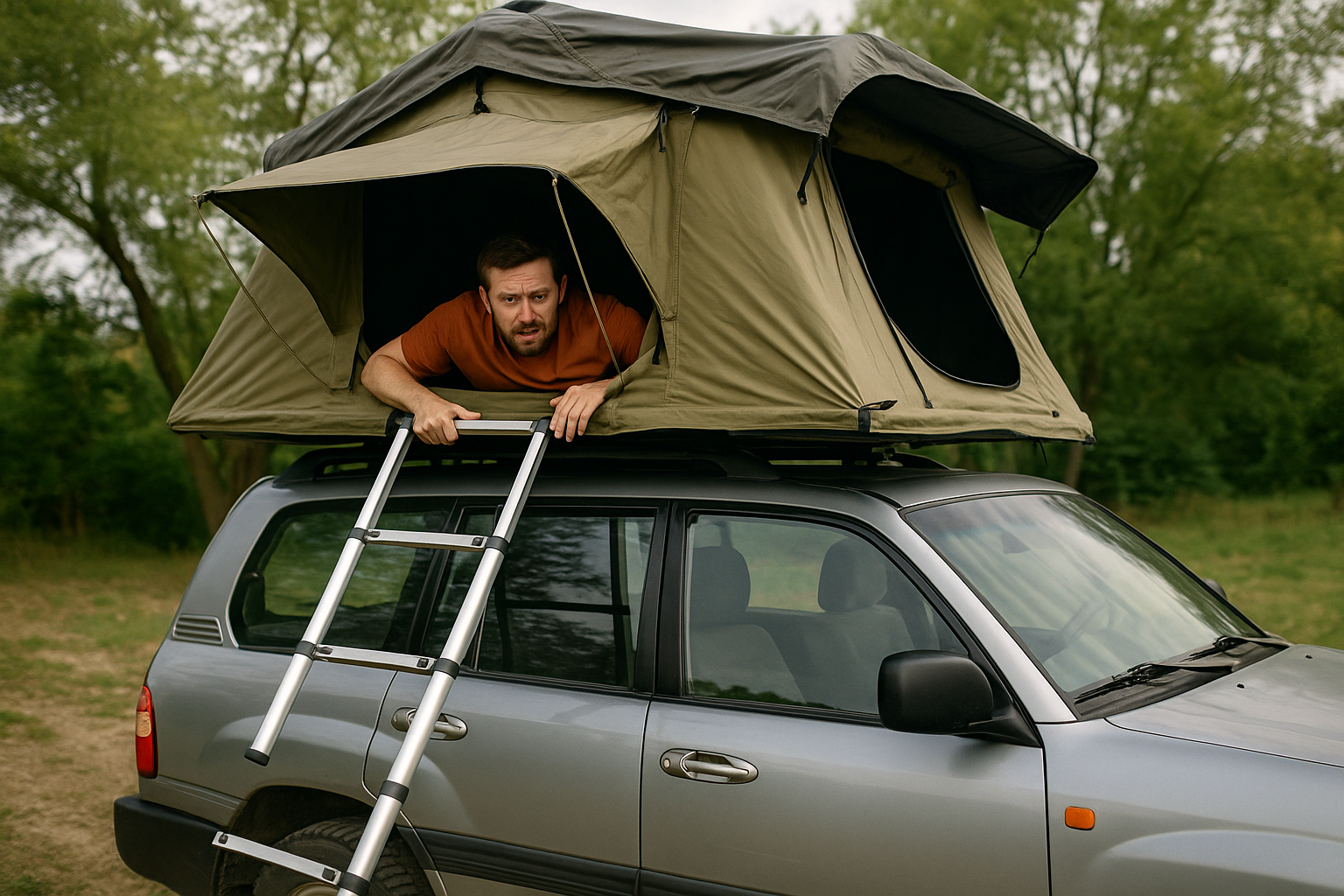The wind’s picked up. You hear a crack. You glance down from your rooftop tent—and the ladder’s snapped, broken, or jammed. You’re stuck up there, facing an emergency. Whether you’re alone or with someone else, climbing down isn’t just about improvisation—it’s about safe, controlled descent with what’s on hand. Forget waiting for rescue. Here’s how to get down safely and strategically from a rooftop tent with a broken ladder, using the survivalist mindset you can trust.
1️⃣ Assess the Situation: Don’t Jump Blindly
Before making any moves:
- Check the ladder for partial integrity—sometimes one side or a few rungs are usable.
- Evaluate the tent’s height—is it a 5-foot drop or closer to 8 feet?
- Look for natural cushioning below—grass, sand, or soft earth.
🛠 Why it matters: A controlled, calculated approach prevents panic injuries.
2️⃣ Rig an Emergency Descent Line
If you have paracord, tow rope, or even ratchet straps:
- Tie a secure anchor inside the tent—loop it around a strong support like a roof rack or tent frame.
- Lower the rope to the ground, ensuring it’s long enough.
- Test its strength before applying weight.
- Descend slowly, using the rope as a handline, bracing feet against the side of the vehicle.
🛠 Why it works: A controlled descent line replaces the ladder with a field-ready rope alternative.
3️⃣ Improvise a Rope Using What You Have
No rope? Improvise:
- Tie together shoelaces, tent guy lines, ratchet straps, or strong clothing (like belts or hoodies).
- Create secure knots, like square knots or figure-8s, for stability.
- Test the line by applying gradual weight before committing to the descent.
🛠 Why it works: Improvised rope lines can support descent when anchored properly and tested.
4️⃣ Lower Gear First
Before climbing down:
- Tie your backpack, cooking gear, or heavy items to the descent line and lower them.
- This reduces the risk of injury from falling objects and lightens your own descent.
🛠 Why it works: Managing gear weight improves balance and safety during descent.
5️⃣ Use the Vehicle as a Step-Down Platform
If your tent sits on a vehicle with a roof rack or hood:
- Climb carefully onto the roof rack or vehicle hood as an intermediate step.
- Brace yourself using grab handles, door frames, or mirrors.
- Lower yourself from the vehicle’s edge, using bumper bars or tire treads for footing.
🛠 Why it works: Breaking the descent into manageable steps reduces impact risk and maintains control.
6️⃣ Cushion Your Landing
Prepare the ground:
- Throw down sleeping bags, foam pads, or spare clothing to cushion your landing area.
- If available, use branches, pine boughs, or sand to create a soft landing zone.
🛠 Why it works: A cushioned landing absorbs shock and reduces injury risk from the final drop.
7️⃣ Controlled Hang and Drop
When no descent line is available:
- Sit at the tent’s edge, facing the vehicle.
- Lower yourself down slowly, hanging by your hands to reduce drop height.
- Drop from as close to the ground as possible, knees bent and feet first, ready to roll or absorb impact.
🛠 Why it works: A controlled drop minimizes fall distance and distributes impact safely.
8️⃣ Leverage Tent Components as Makeshift Descent Aids
In a pinch:
- Detach tent poles, straps, or fabric pieces to use as handholds or descent aids.
- Tie strong fabric sections together to extend reach or create a handline.
- Brace against the tent frame as you climb down.
🛠 Why it works: Improvised tools can provide grip and stability for a safer descent.
9️⃣ Call for Help—But Prepare to Act
If the situation allows:
- Use a phone, whistle, or signal device to alert others nearby.
- Prepare a descent plan anyway, in case help doesn’t arrive quickly.
- Stay calm and conserve energy while waiting or descending.
🛠 Why it works: Having a backup plan gives you control over the situation.
10️⃣ Prevention Tactics for Future Trips
Before you find yourself stuck again:
- Regularly inspect your ladder for cracks, loose bolts, and stress points.
- Carry extra paracord, ratchet straps, or a compact rescue rope.
- Learn basic knots and anchoring techniques before heading into the field.
- Always plan a descent alternative, especially in isolated areas.
🛠 Why it works: Preparedness minimizes emergency risks and keeps you in control.
Real-World Camper Tips:
🔹 “I tied my jacket sleeves together into a makeshift rope when my ladder snapped—I got down safely.”
🔹 “Always keep a 50-foot length of paracord in your rooftop tent—it’s saved me more than once.”
🔹 “Sleeping bags and ground pads turned a dangerous jump into a manageable landing.”
Conclusion:
A broken rooftop tent ladder doesn’t have to leave you stranded. With a clear head, field improvisation, and a bit of creativity, you can descend safely—using ropes, gear, or even your own vehicle as tools. Whether it’s a paracord lifeline or a cushioned landing, these hacks turn a risky situation into a controlled escape.
🧗 Stay resourceful, stay safe, and never let a broken ladder dictate your night.

